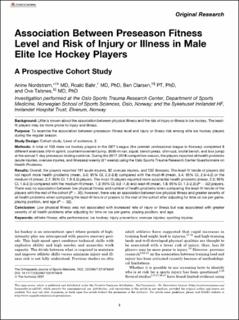Association Between Preseason Fitness Level and Risk of Injury or Illness in Male Elite Ice Hockey Players: A Prospective Cohort Study
Peer reviewed, Journal article
Published version
Permanent lenke
https://hdl.handle.net/11250/2990640Utgivelsesdato
2022Metadata
Vis full innførselSamlinger
- Artikler [5068]
- Publikasjoner fra CRIStin FHI [7544]
Originalversjon
Orthopaedic Journal of Sports Medicine (OJSM). 2022, 10 (2), . 10.1177/23259671221076849Sammendrag
Background: Little is known about the association between physical fitness and the risk of injury or illness in ice hockey. The least-fit players may be more prone to injury and illness. Purpose: To examine the association between preseason fitness level and injury or illness risk among elite ice hockey players during the regular season. Study Design: Cohort study; Level of evidence, 2. Methods: A total of 133 male ice hockey players in the GET League (the premier professional league in Norway) completed 8 different exercises (40-m sprint, countermovement jump, 3000-m run, squat, bench press, chin-ups, brutal bench, and box jump) at the annual 1-day preseason testing combine. During the 2017-2018 competitive season, the players reported all health problems (acute injuries, overuse injuries, and illnesses) weekly (31 weeks) using the Oslo Sports Trauma Research Center Questionnaire on Health Problems. Results: Overall, the players reported 191 acute injuries, 82 overuse injuries, and 132 illnesses. The least-fit tercile of players did not report more health problems (mean, 3.0; 95% CI, 2.2-3.8) compared with the most-fit (mean, 3.4; 95% CI, 2.6-4.2) or the medium-fit (mean, 2.7; 95% CI, 1.9-3.5) players. The most-fit players reported more substantial health problems (mean, 2.0; 95% CI, 1.6-2.5) compared with the medium-fit (mean, 1.3; 95% CI, 0.8 -1.8) and least-fit (mean, 1.8; 95% CI, 1.3-2.3) (P = .02) players. There was no association between low physical fitness and number of health problems when comparing the least-fit tercile of the players with the rest of the cohort (P > .05); however, there was an association between low physical fitness and greater severity of all health problems when comparing the least-fit tercile of players to the rest of the cohort after adjusting for time on ice per game, playing position, and age (P = .02). Conclusion: Low physical fitness was not associated with increased rate of injury or illness but was associated with greater severity of all health problems after adjusting for time on ice per game, playing position, and age. Association Between Preseason Fitness Level and Risk of Injury or Illness in Male Elite Ice Hockey Players: A Prospective Cohort Study
